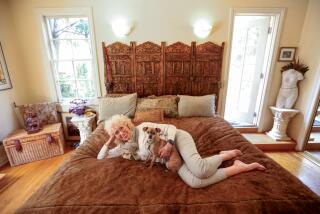Wall Beds Are Springing Back Into Use : Furnishings: In this age of small secondary bedrooms, interior decorators are reviving Murphy’s bed to help create a guest room.
- Share via
Guest rooms are generally a lot like century plants, lying fallow for years until blooming with the arrival of a blood relative (or a bloody relative, if you’re British) for an extended stay.
Otherwise, they gather a lot of dust, piles of ironing, clothes, books and other items destined for the Goodwill.
The major obstacle to using the space for anything else--such as an office or recreation room--is the bed. Whether it’s twin or king-sized, any bed will dominate the room, limiting its functions and its decor.
Sofa beds, of course, can provide one solution, especially if your guests use full body casts for pajamas. (If they can put a man on the moon, why can’t they design a sofa bed that doesn’t crease the spine? Because the mattress has to be light enough to fold, that’s why.)
A possibly perfect answer to the guest room problem comes from the past, and it is one that a growing number of interior decorators are turning to in this age of tiny secondary bedrooms: the wall bed.
But not the wall beds we remember from the Marx Brothers--those cots that folded out of the closet like Grandma’s ironing board and occasionally slammed back into place carrying the sleeper with them.
Today’s wall beds use standard mattresses and box springs, come in all the sizes you would find in your average sleep shop and range in style from the simply utilitarian to the simply elegant.
“They make a lot of sense,” says Jason Titus of Johnson & Titus Interior Design of Irvine, “especially for home offices. You can build a desk, shelves and whatever else you need around the wall bed.”
Although he insists there are some modern sofa beds that are “quite comfortable,” he points out that in many newer homes, “you can’t get a sofa bed into the room, either because of the tight configuration of the hallway or stairs.”
Costa Mesa interior designer Walter Nutting agrees, but says their use isn’t confined to newer tract homes with their limited space. “Older homes can use them too,” he said. “They can bring some sense into any spare room.”
The original wall beds were called Murphy beds, after their turn-of-the century inventor, W.C. Murphy, and although the term Murphy bed is considered generic (check your dictionary), Murphy is a brand name and still a leader in the industry.
Its major competitor these days is Sico Inc., although smaller companies are also in the field. And while Sico and Murphy each claim its products are superior, professional designers agree both are excellent.
Both have major outlets in Orange County: Sico at Room Maker Wallbeds in El Toro at 22722 Lambert St. and Murphy at Murphy Beds & Custom Cabinets, 2720 S. Harbor Blvd., Santa Ana.
Gary McGeough, owner of Room Maker Wallbeds, credits hotels and resorts--particularly the suite-concept establishments--with the resurgence of their use, but he says most of his business today is residential.
“We had a customer in here the other day who said he planned to turn an attic into a guest room until he found out it was going to cost him $44,000. He bought one of our most expensive units (it was $7,000) for an existing room and was happy as a clam because he saved more than $35,000 and wound up with a room that had far more uses that he had originally planned.”
Mike Orr, regional manager for Murphy beds in Santa Ana, says his company is doing mostly residential work. “Our commercial clients now make up only about 10% of our business,” he says.
And while both companies offer complete services (meaning they’ll design and build the cabinets around the bed and install the whole thing), they also offer the bare necessities for do-it-yourselfers.
“The basic unit, which consists of the spring mechanism, platform, mattress and springs, will run you a little over $800,” McGeough says. Orr says his price is about the same.
As far as the high end, both agree that depends on how elegant and how many uses you want out of the wall units; $7,000 is not an unrealistic figure, but most people spend far less.
Both Sico and Murphy products come in components, so customers can pick and choose for their own needs. In addition to the basic bed, both offer chests, glass-door cabinets, wood-door cabinets, desks, credenzas, closets, filing cabinets--even remote control for the beds, which isn’t really necessary because only a touch is required to bring them down onto the floor or place them back into the wall.
The space taken up by a wall bed, incidentally, is surprisingly small--less than 20 inches of depth from the bed cabinet to the wall. Width obviously depends on size of the bed and number of components.


